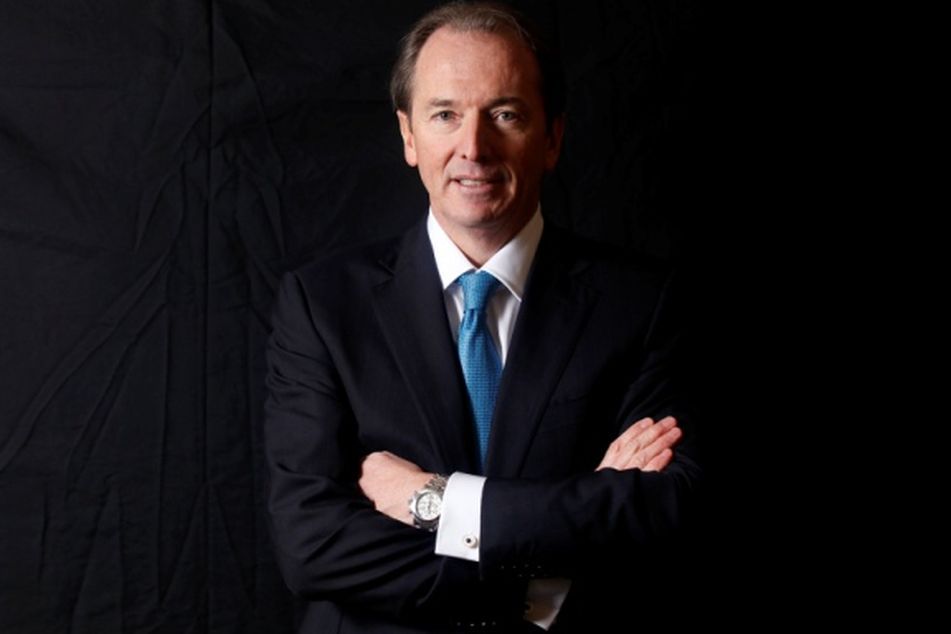James Gorman: Market doesn’t ‘understand’ Smith Barney deal

James Gorman, the CEO of Morgan Stanley, says the market doesn't understand the potential of the firm's acquisition of Smith Barney. "They're focused on what our margins have been."
James Gorman strides across the stage of the auditorium on the top floor of Morgan Stanley’s Times Square headquarters. It’s late October, and he’s in the midst of the second investor revolt he’s been through in three years — the first one coming during the financial upheaval of 2008.
Morgan Stanley’s chief executive officer, a 53-year-old Australian, is addressing employees a day after the bank released its earnings. And he has just finished a media blitz to ward off persistent rumors that Morgan Stanley is heavily exposed to shaky European debt. The whispers, which the bank has denied, have helped drive its stock down almost 50 percent over the course of 10 weeks.
Gorman asks managing director Tom Wipf, a 25-year Morgan Stanley veteran who’s in the audience, if he felt the strain as the firm’s shares dropped below $12 a share. Wipf shakes his head from side to side.
“That’s right; you’re battle-hardened,” Gorman says. “You’ve seen real stress.” Gorman turns to the standing-room crowd. “For those of us who lived through the last crisis, that was real stress.”
That a 50 percent share-price drop in a little more than two months doesn’t trigger real stress says a lot about the past few years for Morgan Stanley. The 77-year-old investment bank has proved it can survive under the worst circumstances.
In 2008, the bank, then headed by John Mack, warded off collapse by taking more than $100 billion in Federal Reserve loans in the two weeks after Lehman Brothers Holdings Inc. failed — and by selling more than 20 percent of itself to Japan’s Mitsubishi UFJ Financial Group Inc.
Now, Gorman, who came to Morgan Stanley in 2006 as head of its brokerage after holding the same job at Merrill Lynch & Co., must show that the bank can make money at a time when investment banks are constrained by roiled markets, sharply reduced trading and deal volume and new regulations that have banned most proprietary trading.
At the same time, investors frightened by the potential unraveling of the euro zone are shunning bank shares. Revenue and profits are down and so is compensation — including Gorman’s, which fell 25 percent in 2011 from the previous year.
In December, Gorman completed his second year as CEO, and on Jan. 1 the board of directors handed him the job of chairman after Mack stepped down from a role he had held since 2005. To put five years of writedowns and government bailouts behind him, Gorman is unloading unprofitable investments and expanding in relatively low-risk areas such as currency trading. He has abolished the bank’s proprietary-trading operations, built up a $54 billion capital cushion and sharply reduced leverage.
Gorman has reorganized the firm around three businesses: wealth management, investment banking and trading, and he has set a target of 15 percent return on equity — modest compared with the 23 percent the bank earned in 2006. The bank’s ROE in 2011 was 4 percent.
“We’ve been among the most aggressive in repositioning our firm,” Gorman, wearing a gray suit with blue pinstripes, says in a conference room down the hall from his office on a rainy December morning. “All you can do against a backdrop of uncertainty is build the business as best you can for how you think the future environment is going to look, and do so aggressively.”
Gorman’s most assertive move has been to turn back the clock 15 years and look for profit in his retail brokerage. He and Mack created a joint venture between the firm’s old Dean Witter brokerage and Citigroup Inc.’s Smith Barney in June 2009 and took a controlling 51 percent stake in the unit, which Gorman ran before his promotion to CEO.
With 17,000 advisers and $1.65 trillion under management, Morgan Stanley Smith Barney is now the world’s largest retail brokerage, surpassing Bank of America Corp.’s Merrill Lynch, which boasts $1.5 trillion. Morgan Stanley in 2011 generated 41 percent of its revenue from that unit compared with 16 percent in 2006.
Gorman has set a target of 20 percent pretax profit for Morgan Stanley Smith Barney, which is the bulk of the bank’s wealth-management division. The unit is run by Greg Fleming, a Merrill Lynch veteran whom Gorman hired in 2009. At the end of 2011, the brokerage was a long way from its goal, with a margin of 10 percent for the year.
The brokerage has been held back by delays in the integration of Dean Witter and Smith Barney technology, Gorman says, and will prove its worth in the long term.
“The market doesn’t understand the potential of the Smith Barney acquisition,” he says. “Instead, they’re focused on what our margins have been in the last financial crisis and during all the integration.”
It was a dismal fourth quarter for big banks, capping off a year in which Europe’s debt woes and a slowing global economy drove down deal volumes and trading activity. Mergers and acquisitions were down last year by 44 percent, to $2.28 trillion, from their 2007 peak, while U.S. equity-trading volumes were down 20 percent from 2009, according to data compiled by Bloomberg.
The financial firms’ response has been to take a hatchet to staff and compensation. Banks globally announced more than 230,000 job cuts last year, according to Bloomberg data.
For its part, Morgan Stanley said in December it would cut 1,600 jobs, and in January it reduced pay for senior bankers by 20 percent to 30 percent. Among those who took a hit: Gorman himself, whose compensation package for 2011 totaled $10.5 million, according to people familiar with the decision, a 25 percent drop from the $14 million he was awarded in 2010.
He won’t receive a cash bonus, while 2011 cash bonuses for other employees were capped at $125,000. In 2006, cash bonuses for the firm’s top traders and investment bankers were as high as $12 million.
Gorman hasn’t been able to look to the stock for support of his decisions. On Feb. 3, Morgan Stanley shares traded at $20.31, 25 percent below what they were worth when he took over. They fell 44 percent in 2011.
“We’re stronger,” he says of progress made in 2011. “We have $8 billion more capital. We have spun off a bunch of prop businesses. And we’ve gone down half in value because of that? Why?”
Morgan Stanley has rebounded so far in 2012. It’s up 34 percent through Feb. 3, as U.S. economic growth shows signs of accelerating and European leaders move closer to a solution on the region’s debt crisis. The firm’s shares also got a boost from news that Morgan Stanley would lead the underwriting of Facebook Inc.’s initial public offering.
“There’s a little bit of relief,” Gorman said on Jan. 25. “There are signs the U.S. economy is doing a little better, unemployment ticking down.”
Gorman doesn’t fit the image of a Wall Street titan. Notwithstanding his $10.5 million pay package, he shows up at black-tie events in a rumpled tuxedo he bought as a business- school student in the 1980s. He keeps supplies of Vegemite — a favorite Australian food that’s made from yeast extract — in the executive kitchen and eats it on toast. The 6-foot-3-inch, 195-pound Gorman’s favorite pastimes include reading John le Carre spy novels and taking weekly boxing lessons.
Gorman is the sixth of 10 children born to Melbourne engineer Kevin Gorman. His father, now 90 once had each of his children take an IQ test, James says. He posted the results in the family’s living room, with each child’s score and expected occupation. James, whose sister is now a judge on the Supreme Court of Victoria, came in fifth — a result that relegated him to an expected job of “midlevel bureaucrat or manager,” he recalls.
“I think I succeeded in that,” Gorman quipped in a November speech as honoree of the American Australian Association.
As Gorman begins his third year as CEO, Morgan Stanley’s business mix and revenue breakdown look almost identical to the 2004 and 2005 versions at Merrill Lynch during Gorman’s final years there.
Gorman’s 15 percent ROE target is roughly what Merrill produced in his last years there. Merrill, however, did it with much higher leverage — which can be used to multiply gains — while under the Basel III rules, Morgan Stanley and other big banks will have to keep leverage down in order to maintain reserve capital at required levels.
Even if the new mix of revenue sources is the right one, Michael Mayo, a bank analyst at CLSA Ltd., wonders whether the firm will be any better at executing than it was in the past. In 2007, Morgan Stanley lost more than $9 billion trading mortgage- related securities for its own account. And in 2009, it scaled back on risk at a time when markets were recovering.
“The problems have really stretched back almost a decade, so a few quarters only represents early days of measuring their progress,” Mayo says. “It really comes down to two words: Show me.”
Gorman’s overriding goal is to convince employees, and the markets, that a Morgan Stanley turnaround is imminent.
“We were the last guys to get through the last crisis,” says Gorman, whose firm posted per-share losses through the second quarter of 2009. “Now, we are in much stronger shape than we were — and than we are perceived to be. But that’s OK. The market will eventually catch up.”
—Bloomberg
Learn more about reprints and licensing for this article.





